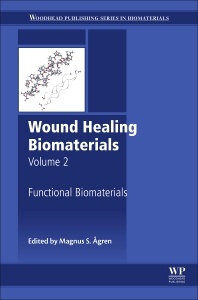Wound Healing Biomaterials - Volume 2 Functional Biomaterials Woodhead Publishing Series in Biomaterials Series
Coordonnateur : Ågren Magnus

Wound Healing Biomaterials: Volume Two, Functional Biomaterials discusses the types of wounds associated with trauma, illness, or surgery that can sometimes be extremely complex and difficult to heal. Consequently, there is a prominent drive for scientists and clinicians to find methods to heal wounds opening up a new area of research in biomaterials and the ways they can be applied to the challenges associated with wound care.
Much research is now concerned with new therapies, regeneration methods, and the use of biomaterials that can assist in wound healing and alter healing responses. This book provides readers with a thorough review of the functional biomaterials used for wound healing, with chapters discussing the fundamentals of wound healing biomaterials, films for wound healing applications, polymer-based dressing for wound healing applications, and functional dressings for wound care.
Part One Fundamentals of wound healing biomaterials
1 Introduction to biomaterials for wound healing
P. Aramwit
2 Modelling of cell–tissue interactions in skin
L.E. Smith
3 Biofilms in wounds and wound dressing
P.L. Phillips, R.D. Wolcott, L.J. Cowan and G.S. Schultz
4 The importance of preventing and controlling biofilm in wounds: biofilm models and nanotechnology in antibiofilm approaches
D.B. Barbosa, A.M. Agostinho Hunt, A. Berretta, E. Rodrigues deCamargo, L.F. Gorup, D.R. Monteiro, G.L. Fernandes, R.A. Fernandes and K.R. Kirker
5 Control and treatment of infected wounds
K. Saleh and H.H. Sönnergren
Part Two Biomaterial films for wound healing
6 Multilayer films for reducing bleeding and infection
B.B. Hsu
7 Collagen-based formulations for wound healing applications
C.H. Lee and Y. Lee
8 Cyanoacrylate tissue glues for cutaneous wound closure
F.P. Robertson, L.J. Magill, C. Davidson, H. Mitchell and B.R. Davidson
Part Three Polymer biomaterials and dressings for wound healing
9 Collagens in wound healing
A. Nyström
10 Microparticulate polymers and hydrogels for wound healing
R. Ghadi, A. Jain, W. Khan and A.J. Domb
11 Engineered hydrogel-based matrices for skin wound healing
L.P. da Silva, M.T. Cerqueira, V.M. Correlo, R.L. Reis and A.P. Marques
12 Exploring the role of polyurethane and polyvinyl alcohol foams in wound care
M. Sambasivam, R. White and K. Cutting
13 Biopolymers as wound healing materials
A.M. Smith, S. Moxon and G.A. Morris
14 In situ–formed bioactive hydrogels for delivery of stemcells and biomolecules for wound healing
Y. Dong and W. Wang
15 Polystyrene-based wound healing systems
M. Mobed-Miremadi, D. Grandio and J. Kunkel
16 Silver-doped hydrogels for wound dressings
S.T. Meikle
17 Keratins in wound healing
R. Kelly
Part Four Other functional biomaterial dressings for wound healing
18 Activated protein C to treat chronic wounds
C.J. Jackson and M. Xue
19 Clay minerals for tissue regeneration, repair, and engineering
G. Sandri, M.C. Bonferoni, S. Rossi, F. Ferrari, C. Aguzzi, C. Viseras and C. Caramella
20 Silver-containing dressings
K. Ousey, C. Roberts and D. Leaper
21 Antibacterial effects of titanium dioxide in wounds
H.J. Haugen and S.P. Lyngstadaas
22 Bioactive nanofiber dressings for wound healing
O.S. Manoukian, A. Ahmad, C. Marin, R. James, A.D. Mazzocca
and S.G. Kumbar
23 Nanofibrous smart bandages for wound care
M. Mohiti-Asli and E.G. Loboa
Researchers in industry, academia and clinics with an interest in wound healing
- Includes more systematic and comprehensive coverage on the topic of wound care
- Provides thorough coverage of all specific therapies and biomaterials for wound healing
- Contains clear layout and organization that is carefully arranged with clear titles and comprehensive section headings
- Details specific sections on the fundamentals of wound healing biomaterials, films for wound healing applications, polymer-based dressing for wound healing applications, and more
Date de parution : 06-2016
Ouvrage de 542 p.
15x22.8 cm
Thèmes de Wound Healing Biomaterials - Volume 2 :
Mots-clés :
Action-Mechanism; Activated protein C; Alginate; Angiogenesis; Antimicrobial; Antiseptics; Bandages; Bioactive hydrogels; Bioactivity; Bioburden; Biocompatibility; Biofilm; Biofilms; Biomaterials; Biopharmaceuticals; Burns; Cell adhesion and proliferation; Cell differentiation; Chitosan; Chronic wounds; Clay minerals; Collagen; Cyanoacrylate tissue glue; Dehiscence and infection; Dermis; Dressing; Dressings; Drug delivery; Electrospinning; Endothelial cells; Epidermis; Epidermolysis bullosa; Epithelialization; Fibers; Formulations; Gelatin; Gellan; Green; Hemostasis; Hydrogel; Hydrogels; Infection; Keratin; Keratinocytes; Microparticles; Moist wound healing; Nanocomposites; Nanofiber based; Nanofiber; Nanofibers; Nanoparticles; Nanotechnology; Natural polymers; Natural; Negative pressure wound therapy; Pathology; Pectin; Photoactivated TiO2; Polyelectrolyte multilayers; Polymers; Polysaccharide based; Polystyrene-based hydrocolloid dressing; Polyurethane foam; Polyvinyl alcohol foam; Protein based; PU membrane; Reactive oxygen species (ROS)Titanium dioxide; Scaffold; Silver dressings; Silver nanoparticles; Silver; Skin model; Skin Substitute; Skin tissue engineering; Skin; Species differences; Spongy-like hydrogels; Stem cells; Stimulation; Styrene; Surgical wounds; Sutures; Synthetic polymers; Synthetic; Therapy; Thermoplastic elastomer; Tissue engineering; Traumatic injury; Ulcers; Wound care; Wound classification; Wound dressing; Wound healing; Wound infection; Wound; Wounds


